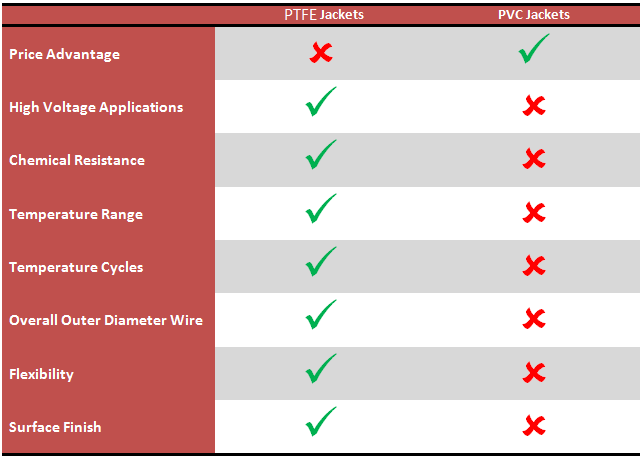PVC vs Polytetrafluoroethylene (PTFE) Wire Jackets
Based on the application, it may be difficult to pick the most suitable wire jacket. Often the choice boils to between Polytetrafluoroethylene jackets and PVC jackets. However, when the two types of jackets are compared, one will find that they are really quite different. One of the key differences between the two jackets is their price points.
When comparing the prices, it is easy to notice that Polytetrafluoroethylene wire is significantly more expensive than PVC wire. However, that is driven by the fact that there are many differences between PVC and Polytetrafluoroethylene wire. Each has its own unique properties, and can be used in different applications and project requirements.

PVC, or polyvinyl chloride, is also known as vinyl. It is arguably the most dominant type of wire jacket available on the market. However, it is not designed for high-voltage applications. It is more suitable for low-voltage applications, and Polytetrafluoroethylene is usually better suited for higher voltage applications. PVC jackets are available in may different flavours for various applications. Additionally, PVC can differ as far as pliability and electrical properties go. Because of this, the prices off different PVC jackets can vary siginificantly. There are three different commonly known types of PVC. They include:
- Standard PVC, usually used for commercial and industrial applications. It is also used in computer and control wires applications.
- Semi Rigid PVC, tougher than the common PVC wire as well as the fact that its electrical properties are more stable, which means that it offers better protection then the first type.
- Indicated PVC, possesses unusually high resistance to abrasion. It should also be noted that it is also not thermoplastic.
PVC cables have good electrical properties that vary over a wide temperature range. Considering how durable and long lasting they are, for most applications they are fairly suitable. However, PVC wires do have some undesirable properties; for example, PVC wires should not be used in temperatures, which are above seventy degrees Celsius. Their thermal rating is limited. Also, it should be noted that the thermal decomposition of PVC has Hydrochloric Acid (HCI) as a bi-product.
Polytetrafluoroethylene has better electrical properties than PVC. It also has a higher temperature range and chemical resistance. Consequently, it is often refered to as high temperature wire. Unlike PVC wire jackets, which cannot be subjected to ultra-violet light for an extended amount of time, Polytetrafluoroethylene can. However, like PVC, Polytetrafluoroethylene should not be used in high-voltage applications. There are two types of Polytetrafluoroethylene wire:
- TFE wire jackets can be manufactured in long lengths because of the material from which it is made.
- FEP wire jackets can be manufactured in long lengths that are continuous. Additionally, they can be color coded for control applications.
Polytetrafluoroethylene offers significant number of advantages in most applications; often the biggest drawback of using Polytetrafluoroethylene jackets is the cost. Polytetrafluoroethylene is impervious to many different chemicals, including acid, hydrocarbons and other solvents. It is easy to sterilize. It also has a low volumetric expansion characteristic. It can also withstand extreme hot and cold temperatures cycles better then PVC jackets. However, some soldering processes can reach the temperature limit of Polytetrafluoroethylene, which in-turn carries its own set of health hazards.